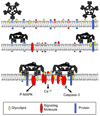Cellular mechanisms of central nervous system repair by natural autoreactive monoclonal antibodies
- PMID: 20008649
- PMCID: PMC2796600
- DOI: 10.1001/archneurol.2009.262
Cellular mechanisms of central nervous system repair by natural autoreactive monoclonal antibodies
Erratum in
- Arch Neurol. 2010 Apr;67(4):518. Edberg, Dale E [corrected to Edberg, Dale D]
- Arch Neurol. 2010 Feb;67(2):147
Abstract
Natural autoreactive monoclonal IgM antibodies have demonstrated potential as therapeutic agents for central nervous system (CNS) disease. These antibodies bind surface antigens on specific CNS cells, activating intracellular repair-promoting signals. IgM antibodies that bind to surface antigens on oligodendrocytes enhanced remyelination in animal models of multiple sclerosis. IgM antibodies that bind to neurons stimulate neurite outgrowth and prevent neuron apoptosis. The neuron-binding IgM antibodies may have utility in CNS axon- or neuron-damaging diseases, such as amyotrophic lateral sclerosis, stroke, spinal cord injury, or secondary progressive multiple sclerosis. Recombinant remyelination-promoting IgM antibodies have been generated for formal toxicology studies and, after Food and Drug Administration approval, a phase 1 clinical trial. Natural autoreactive monoclonal antibodies directed against CNS cells represent novel therapeutic molecules to induce repair of the nervous system.
Figures



References
-
- Coutinho A, Kazatchkine MD, Avrameas S. Natural autoantibodies. Curr Opin Immunol. 1995 Dec;7(6):812–818. - PubMed
-
- Howe CL, Bieber AJ, Warrington AE, Pease LR, Rodriguez M. Antiapoptotic signaling by a remyelination-promoting human antimyelin antibody. Neurobiol Dis. 2004 Feb;15(1):120–131. - PubMed
-
- Paz Soldan MM, Warrington AE, Bieber AJ, et al. Remyelination-promoting antibodies activate distinct Ca2+ influx pathways in astrocytes and oligodendrocytes: relationship to the mechanism of myelin repair. Mol Cell Neurosci. 2003 Feb;22(1):14–24. - PubMed
-
- Pirko I, Ciric B, Gamez J, et al. A human antibody that promotes remyelination enters the CNS and decreases lesion load as detected by T2-weighted spinal cord MRI in a virus-induced murine model of MS. Faseb J. 2004 Nov;18(13):1577–1579. - PubMed
-
- Banks WA, Farr SA, Morley JE, Wolf KM, Geylis V, Steinitz M. Anti-amyloid beta protein antibody passage across the blood-brain barrier in the SAMP8 mouse model of Alzheimer's disease: an age-related selective uptake with reversal of learning impairment. Exp Neurol. 2007 Aug;206(2):248–256. - PMC - PubMed
Publication types
MeSH terms
Substances
Grants and funding
LinkOut - more resources
Full Text Sources
Other Literature Sources
Medical

